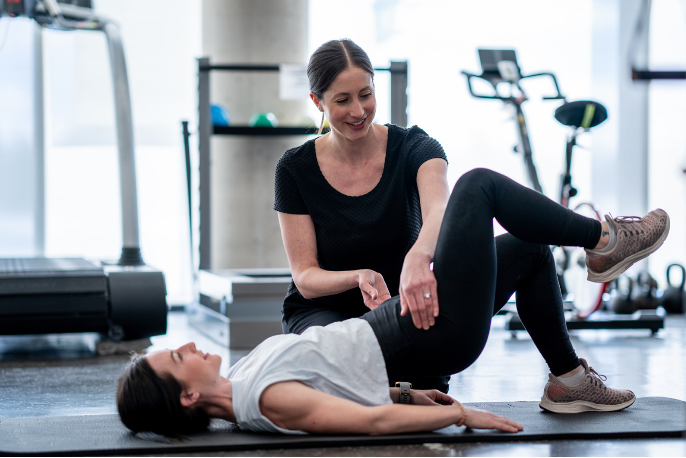Affecting approximately 1 in 5 Australians, chronic pain is a lot more common than many people think (1). Anyone who has experienced chronic pain knows how debilitating it can be, limiting daily activities and negatively impacting overall quality of life. While medications can help manage pain, they often come with unwanted side effects.
Exercise, on the other hand, is a natural and effective way to help alleviate chronic pain for many people. In this blog, we will explore the physical and biological ways that exercise can help manage chronic pain.
Moving to Get Things Moving
Exercise is a powerful tool for getting your body moving in more ways than one. By increasing blood flow to your muscles, tissues, and nerves, exercise delivers essential oxygen and nutrients while removing waste products, improving their health and function. This in turn can reduce inflammation, promote healing, and help alleviate chronic pain (2).
Furthermore, movement can help with joint pain and stiffness by promoting joint lubrication. Many people have been privy to how problematic joints can feel worse first thing in the morning. This is because as you move, your joints release synovial fluid, which reduces friction and allows for freer movement (5), hence breaking up time spent sedentary with movement can provide relief. This can be especially beneficial for people with conditions like osteoarthritis, which often cause joint discomfort.
A Natural Painkiller
Regular exercise can be a powerful natural analgesic for chronic pain sufferers. One way exercise helps is by triggering the release of endorphins, the body’s natural painkillers (3). These endorphins interact with receptors in the brain, reducing the perception of pain and creating a sense of euphoria commonly known as the “runner’s high.” Endorphins can also improve mood and reduce stress and anxiety in an overall sense, which are all significant contributors to chronic pain.
Another way exercise helps is by decreasing nervous system sensitivity. Over time, chronic pain can make the nervous system more sensitive to pain signals, but research has shown that exercise can help “reset” the nervous system, leading to reduced pain and improved daily functioning. This is particularly true for people with conditions such as fibromyalgia, where regular exercise has been shown to decrease nervous system sensitivity and reduce pain (4).
Straightening Up!
If you’re experiencing chronic pain, it’s possible that certain musculoskeletal problems could be contributing to your discomfort. Issues like weakness, poor movement patterns, and postures that put strain on sensitised areas can all play a role in chronic pain. The good news is that exercise can help! By engaging in targeted strengthening exercises. For example, you can help alleviate back pain by improving spinal stability and reducing the strain on your lower back.
Chronic pain is complex and affects everyone differently. While exercise can be a powerful tool, it is essential to remember that everyone’s experience with pain is unique. Finding the right type and intensity of exercise that works for you may take some trial and error. However, by working with an exercise physiologist and being patient and persistent, things can get better.
It’s important to note, that these physical changes are only a small part of the chronic pain puzzle.
Keep an eye out for part two in coming weeks, where we explore the all-important psychological benefits of exercise in this space – so stay tuned!
Author: Tessa Nielsen
Clinical Exercise Physiologist and
Content Creator at Specialised Health
References:
- Australian Institute of Health and Welfare. Chronic pain in Australia. Canberra: AIHW, 2019. (Accessed on 13 April 2023) https://www.aihw.gov.au/reports/chronic-musculoskeletal-conditions/chronic-pain-in-australia/contents/summary
- Johnson NA, Stathokostas L. Exercise and inflammation. Aging and Disease. 2013; 4(3): 130-143. (Accessed on 13 April 2023) https://doi.org/10.14336/AD.2013.0400130
- Hoffman MD, Hoffman DR. Does aerobic exercise improve pain perception and mood? A review of the evidence related to healthy and chronic pain subjects. Current Pain and Headache Reports. 2007; 11(2): 93-97.
- Gatchel RJ, Peng YB, Peters ML, Fuchs PN, Turk DC. The biopsychosocial approach to chronic pain: scientific advances and future directions. Psychological Bulletin. 2007; 133(4): 581-624. (Accessed on 13 April 2023) https://doi.org/10.1037/0033-2909.133.4.581
- Bereznicki, T., Javornik, N., Kokol, P. et al. (2021). The effect of exercise on synovial fluid biomarkers: A systematic review and meta-analysis. PLoS ONE, 16(2), e0246475. https://doi.org/10.1371/journal.pone.0246475
#exercisephysiology #exerciserehab #rehabilitation #lifeinsurance #incomeprotection #ctp #workcover #mobile #mobileexercisephysiology #fatigue #mentalhealth #cancer #musculoskeletal #injury #pain #physio #physiotherapy #Sydney #Brisbane #Melbourne #Adelaide #Auckland #Waikato #BayofPlenty #Wellington #Otago #Christchurch



